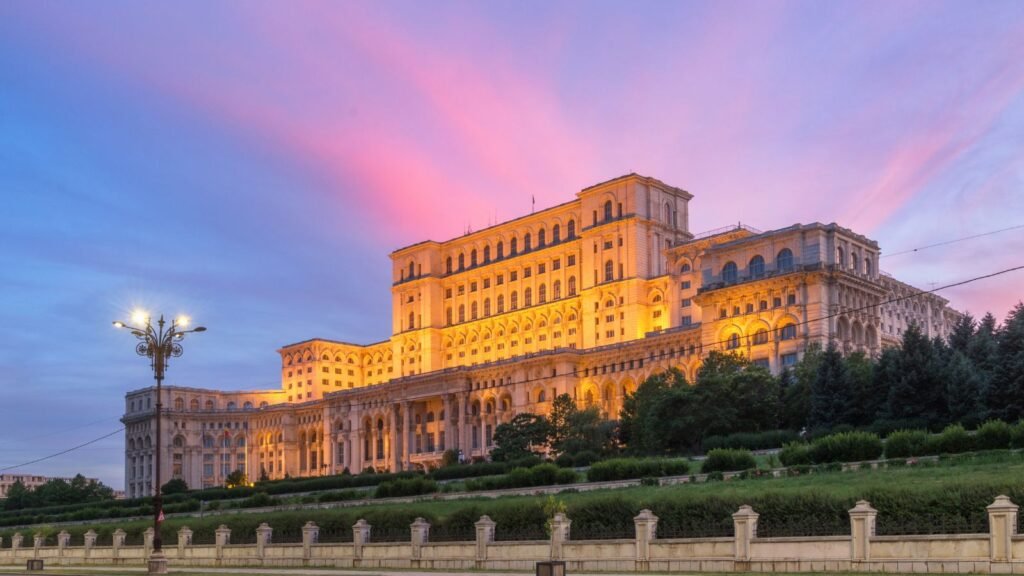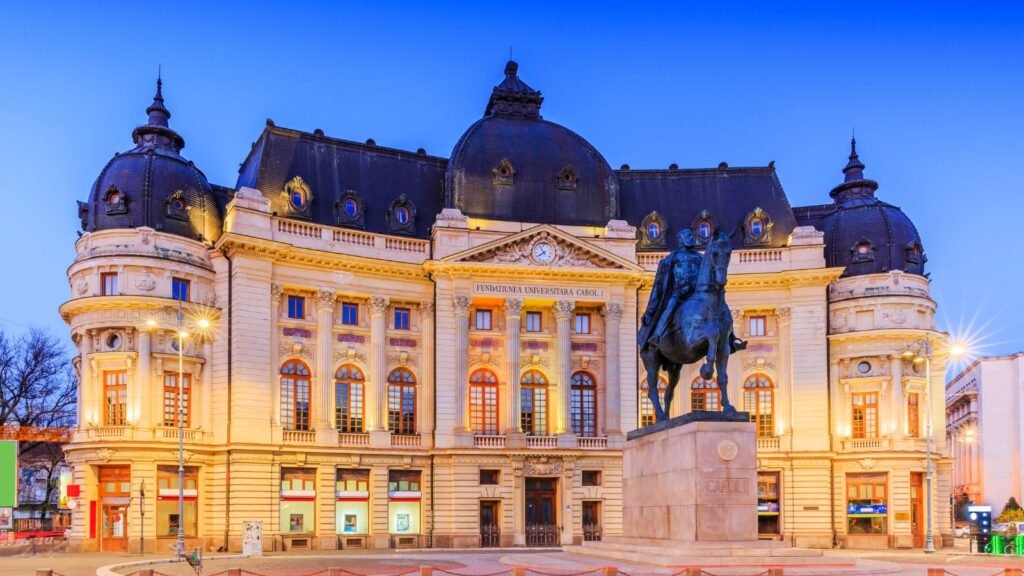Touchdown in Bucharest. The plane lands, your phone pings with a suspiciously cheap roaming offer, and your eyes squint at the strong Romanian sunlight bouncing off everything from Orthodox domes to aggressive 1970s concrete. It’s not so much a welcome as a slap – invigorating, slightly alarming, and definitely unforgettable. You’ve got 48 hours in Bucharest. Let’s not waste time.
Start with coffee. Not just any coffee. Origo, near the Old Town, pours some of the best in the city. Their flat white can bring the dead back to life. The baristas wear beanies and concentration, and the espresso machine hisses like a satisfied cat. Pair your life-giving coffee with a croissant and feel vaguely European. Then take a stroll down Lipscani, the Old Town’s wrinkled, charming face, where medieval meets man-bun in an awkward but endearing dance. Expect cobbles, cafes, vintage shops, and more Orthodox churches than you thought existed outside a Byzantine Instagram feed. If you’re feeling spry, detour into the ruins of Curtea Veche – Vlad the Impaler’s old stomping grounds, now mostly pigeons and uneven stones. Still, it’s got a mood.

Keep walking east until you hit Stavropoleos Monastery. Blink and you’ll miss it – a teeny-tiny church crammed between buildings like a secret whispered by stone. Its courtyard is a hush in the chaos, all carved stone and ivy-covered serenity. The frescoes inside look like they’ve been trying to hold their breath since the 18th century, and they probably have.
Since you’re practically next door, waltz into the National Museum of Romanian History. It’s a building that looks like it regrets being built, but inside is a treasure chest of Roman gold, medieval oddities, and the spectacularly dramatic replica of Trajan’s Column that winds like a boast through the hall. For a proper surreal moment, spend a few minutes admiring the Communist-era uniforms – they look like the cast-offs from a dystopian opera.
Lunch. You’re hungry. Go to Caru’ cu Bere. Yes, it’s touristy. Yes, it’s fantastic. Think Viennese beer hall meets Romanian Dracula cosplay. The menu is large, the waiters wear waistcoats, and there’s probably a live band playing something that sounds suspiciously like accordion jazz. Try the sarmale (cabbage rolls) with a side of polenta, and pretend to understand the folklore vibes oozing from the stained-glass windows. If you’re feeling extra, order the papanasi – doughnuts filled with sour cherry jam and topped with a dangerous amount of cream. You’ll regret nothing but your waistband.

Post-lunch, you need air and irony. Enter the Palace of the Parliament. It’s the second-largest administrative building in the world, but emotionally, it’s the largest cry for help architecture has ever made. Nicolae Ceaușescu wanted something grand. He got it. It’s gigantic, cold, and overcompensating harder than a sports car in a midlife crisis. Book a guided tour unless you want to get lost and accidentally join parliament. Inside, it’s chandeliers, marble, carpets, and existential dread. It’s not beautiful, exactly, but it’s absolutely mesmerising in its excess.
Stretch your legs back towards the Old Town. If the legs protest, bribe them with a detour to the Izvor Park or even better, walk along the Dambovita River – it’s no Seine, but it’s got character. Stop at Linea/Closer to the Moon, a rooftop bar with views and cocktails that don’t skimp. The vibe is somewhere between lunar chic and urban jungle. Watch the sun set over the madness of Bucharest while sipping something with elderflower in it. Pretend this is your city.
Dinner calls for a visit to The Artist. Modern Romanian cuisine, tasting menus, and a slight whiff of ambition waft from every plate. If you can’t pronounce anything on the menu, you’re in the right place. Beetroot foam, dill dust, sous-vide veal cheeks – it’s an edible art gallery. Or, for something cosier and more nostalgic, try Zexe – vintage elegance, candlelight, and a duck stew that might make you emotional. The walls are lined with portraits of poets you’ve never read but feel oddly moved by.
Sleep at Cismigiu Hotel. It’s pretty, it’s central, and it doesn’t smell like regret. Its Art Nouveau bones and rooftop bar make it a quiet hero. Breakfast on the terrace if you can manage it. If not, grab covrigi (Romanian pretzels) from a street vendor and head to Cismigiu Gardens. Ducks, old men playing chess, teenagers practicing TikTok dances – it’s all happening. Feed the ducks. Judge the joggers. Feel superior.
Then march toward the Romanian Athenaeum. Buy a ticket for a tour if there’s no concert. The ceiling is a fresco of Romanian history, with added cherubs. If it doesn’t make you believe in civilised society, nothing will. From there, choose your flavour: cultural or quirky. Cultural means the National Art Museum, housed in the former royal palace. Expect stern portraits, religious icons, and a silence that makes your footsteps sound like gunshots. Quirky means the Museum of the Romanian Peasant, which is way more than just pots and tapestries. It’s folk art meets anti-communist snark, with a side of nostalgia for things you never lived through.
By now you’re peckish again. Lunch like a local at La Mama. Ignore the name. Order ciorbă de burtă (tripe soup). Or don’t – it’s your stomach. They also do a mean tochitură (meat stew with polenta and a fried egg on top) that pairs well with low expectations and high cholesterol. If you’re squeamish, there’s always zacuscă (vegetable spread) and a safe schnitzel. Wash it down with a cold Ursus or something stronger.
Hop on a tram – any tram – and get off when the scenery feels either unexpectedly beautiful or depressingly Soviet. Bucharest does both well. If you land in Cotroceni, you’ve lucked out. It’s all leafy boulevards, 19th-century villas leaning over wrought iron fences, and cats who act like they own the place. Pop into a small cafe, order something inexplicably lavender-flavoured, and eavesdrop on students lamenting their architecture deadlines.
Before dinner, hit Carturesti Carusel, a bookstore so pretty it’s caused Instagram fatigue. Spiral staircases, white balconies, and books you won’t buy. Pretend you’re here for culture, not just the lighting. If you do buy a book, get one about Romanian myths – it’ll give you something to explain to confused friends back home.
Last dinner? Shift the vibe. Try Energiea – it’s modern, it’s hip, it used to be a printing press. They serve craft beer and dishes that look like they’ve been styled by someone with a PhD in Plating. You might get something served in a miniature wheelbarrow. Or choose Mahala – a slightly chaotic homage to urban Romania, where dinner feels like a party with a Balkan soundtrack and where nothing matches, from the chairs to the conversations.
Wrap up the night in Control Club. Live music, DJs, and people too cool to make eye contact. If you’re still standing, you can dance. If not, just lean attractively against a wall and look mysterious. Or, if you’re done with youth and noise, have a quiet one at Gradina Eden, a leafy bar behind an old palace that feels like an urban Narnia. Swinging hammocks, fairy lights, cocktails in jam jars – it’s aggressively whimsical.
Next morning, with half an hour to kill, stop by Obor Market. This is Bucharest raw and unfiltered – pigs’ heads, pickled everything, and the best mici (grilled skinless sausages) in town. Eat three, regret nothing. Buy some smoked cheese or paprika to terrify airport security.
Taxi to the airport, stuffed with cabbage, caffeine, and confusion. After 48 hours in Bucharest you’ll leave slightly baffled but very full. Which, frankly, is exactly how it wants you to feel. It’s not a city that explains itself. It’s a city that dares you to catch up.
